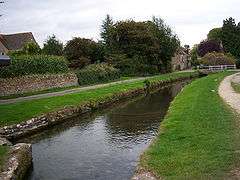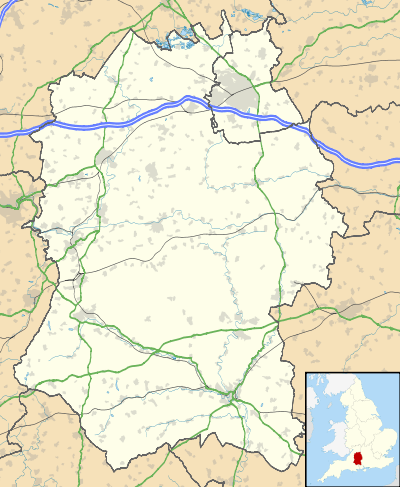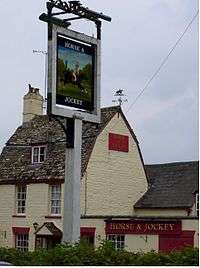Ashton Keynes
Ashton Keynes is a village and civil parish in north Wiltshire, England which borders with Gloucestershire. The village is about 5 miles (8 km) south of Cirencester and 3.5 miles (5.6 km) west of Cricklade. At the 2011 census the population of the parish, which includes the hamlet of North End, was 1,400.[1]
| Ashton Keynes | |
|---|---|
 The Thames entering the village | |
 Buildings and the Thames along the main road through the village (High Road) | |
 Ashton Keynes Location within Wiltshire | |
| Population | 1,400 (in 2011)[1] |
| OS grid reference | SU046940 |
| Unitary authority | |
| Ceremonial county | |
| Region | |
| Country | England |
| Sovereign state | United Kingdom |
| Post town | SWINDON |
| Postcode district | SN6 |
| Dialling code | 01285 |
| Police | Wiltshire |
| Fire | Dorset and Wiltshire |
| Ambulance | South Western |
| UK Parliament | |
| Website | Parish Council |
The village lies within the Cotswold Water Park and is the only settlement substantially on both sides of the River Thames, which has many channels here, centred 6.5 miles (10 km) from its source at Thames Head.
History

The village was known as Aesctun in 800 AD, appeared in the Domesday Book within Cricklade hundred as Essitone in 1086. Ten variants of the name are recorded over the next 800 years.
A large Romano-British settlement was on the edge of the present-day village; it was excavated in the late 1980s in advance of extensive gravel extraction. Ashton Keynes Castle (or Hall's Close) was a 12th-century ringwork, just north of the village.
The manor was held by the de Cahaignes or Keynes family, and this was incorporated into the village name.
Ashton House was built in the 18th century and is Grade II listed.[2]
In 1851 in the 35 homes in Gosditch were living a tailor, saddler, tallow chandler, stonemason, many glove makers and a cobbler. The Horse and Jockey (now closed) was a "scrumpy house", selling cider made from the apples from the orchards in the village.
Religious sites
The Church of England parish church of the Holy Cross is Grade I listed.[3] The building was begun in the 12th century and was restored in 1876-7 by William Butterfield.
A Congregational chapel (Bethesda Chapel) was built in 1838 and closed in 1970.[4] A Primitive Methodist chapel was opened in 1840 and closed in the early 1930s.[5]
Amenities
The local school is Ashton Keynes Church of England School, a voluntary controlled school.[6] Parts of the school building date back to 1870.[7]
Ashton Keynes is twinned with the French village of Grandchamps-des-Fontaines. There is a Twinning Association in the village, which organises regular exchange trips and other activities between the village communities.
The village has many clubs and societies, most centred on the village hall or with links to the village church. Sports clubs include the cricket, tennis, badminton and football clubs. Musical groups include two choirs, an orchestra and a jazz band. There is also a Women's Institute and a Golden Years Club.
Residents in the village have taken on two businesses (both on the High Road) as community businesses when they faced closure. The one remaining pub, the White Hart Inn, is collectively owned and run by several village residents who took on the licence in 2011. In 2012, the White Hart Inn was awarded 'Best Community Pub' for the South West region in the Great British Pub Awards.[8] The local village shop has also been community owned and run since December 2011, located in a newly built annexe of the village hall.[9]
Landmarks
River Thames
Forming many channels through the village and joined by the Swill Brook and smaller tributaries, the Thames at Ashton Keynes has frontage to a large minority of the village's properties.
Ashton Keynes has always suffered from periodic flooding, and the Thames that flows along beside High Road and crosses under Gosditch by the little bridge was prone to washing down to the School and beyond on its near banks. Villagers expected to be flooded every winter, although the water could be controlled and directed to some extent by opening and closing 'hatches' on the river. People talked of keeping their back door and front door open so the water flowed straight through, and of a foot of water standing indoors for weeks. As late as 1924 there were 23 children absent from school in June when flooding in the Derry just south of the Horse and Jockey public house left them marooned in their bedrooms after a night of storms.
Ditches all round the village helped to channel the water, but as these were also used as a place to tip household rubbish and many privies were emptied into them, particularly after the demise of the night soil industry, there was regularly a serious public health problem from rats and water contamination in Gosditch.
Cotswold Community
The Cotswold Community, a site 250 acres (100 ha) in area west of Ashton Keynes towards Somerford Keynes, was a Bruderhof religious community[10] in the 1930s.[11] Later it was the site of the Cotswold School, a therapeutic community for children from complex backgrounds, operated by the National Children's Home charity which became Action for Children. The school closed in 2012[12] and the charity left the site in 2013, leading to a proposal for housing development.[13]
Notable residents
Reginald Dyer, the officer responsible for the Amritsar massacre in 1919, retired to Ashton Keynes and was living in the village at Ashton Fields at the time of his death in 1927.[14]
References
- "Wiltshire Community History - Census". Wiltshire Council. Archived from the original on 23 February 2016. Retrieved 1 September 2015.
- Historic England. "Ashton House, river wall and bridge (1023069)". National Heritage List for England. Retrieved 2 September 2015.
- Historic England. "Church of the Holy Cross, Ashton Keynes (1023045)". National Heritage List for England. Retrieved 1 September 2015.
- "Bethesda Congregational Chapel, Ashton Keynes". Wiltshire Community History. Wiltshire Council. Archived from the original on 23 October 2015. Retrieved 1 September 2015.
- "Primitive Methodist Chapel, Ashton Keynes". Wiltshire Community History. Wiltshire Council. Archived from the original on 22 October 2015. Retrieved 1 September 2015.
- "Ashton Keynes Church of England Primary School". Retrieved 1 September 2015.
- "Ashton Keynes Church of England Primary School". Wiltshire Community History. Wiltshire Council. Archived from the original on 23 October 2015. Retrieved 1 September 2015.
- "Archived copy". Archived from the original on 3 January 2014. Retrieved 24 February 2014.CS1 maint: archived copy as title (link)
- "Village Shop". Ashton Keynes Village Website. Retrieved 1 September 2015.
- "The Cotswold Bruderhof". John Whitwell. 3 July 2009. Retrieved 24 May 2017.
- Historic England. "Ashtonfields community hall and chapel, Cotswolds Community (1182316)". National Heritage List for England. Retrieved 1 September 2015.
- "Annual report and accounts 2012/13" (PDF). Action for Children. 18 July 2013. p. 35. Retrieved 1 September 2015.
- Archer, Megan (1 August 2013). "Plans for a new village for the Wiltshire and Gloucestershire border near Ashton Keynes and Someford Keynes". Wilts and Gloucestershire Standard. Newsquest Media. Retrieved 1 September 2015.
- "DYER C. B. Reginald Edward Harry of Ashton Fields Ashton Keynes Wiltshire died 23 July 1927 at St Martin's Long Ashton near Bristol" in Probate Index for 1927 at probatesearch.service.gov.uk, accessed 17 April 2019
External links
![]()
- "Ashton Keynes". Wiltshire Community History. Wiltshire Council. Archived from the original on 22 October 2015. Retrieved 2 September 2015.
- Village community website
- Ashton Keynes Parish Council
- Ashton Keynes Village Hall
- Ashton [Keynes] in the Domesday Book